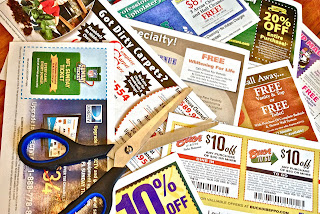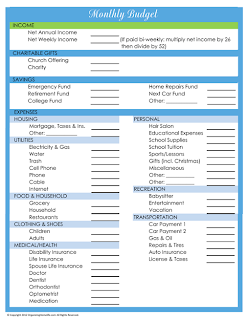Want to read about the rest of the Budgeting 101 Series? Find it: HERE.
How We Save Money
Budgeting 101: Class 8
Saving money isn't just on food. Although Food and Household needs add up quickly, anywhere you can find to cut back or save a bit helps a lot in the long run.
Thankfully, my husband has a great job, and most of these little penny pinching strategies we don't actually need to do... but that doesn't mean we need to live up to our full paycheck. And it also doesn't mean that saving money and living on a budget lower your quality of life. In fact, we have gone through many different stages of spending and I am so much happier when we are on a budget.
So I compiled a list of all the little things I could think of that our family does to save money.
How We Save Money:
We Never buy on credit (other than a home)... if we don’t have
the money we save for it.
We Don't pay for Cable or Dish Network. We have Basic Channels and Netflix.
We Don't have Spendy Cell Phone & Plans (We have data and text, but we share
minutes and buy the phones you can get free with you plan.)
We buy Off Brand
Many food items, household & cleaning items, hygiene
products, etc. we buy off brand. Very few things do I notice a difference between the brands... But
I do have some things I will buy name brand like, Saran Wrap.
When we do buy name brands I look for sales, coupons, etc.
Most everything we wear is a sale item or clearance item. The more you save, the more you can buy.
We avoid Fast Food
This also includes drinks.
We avoid fast food and never buy soft drinks. Both of these aren’t healthy and the cost adds
up quickly. As we have cut back it also
is now a reward to our kids instead of an expectation. And Happy Meals are for a “kid date” or
special occasion/reward.
Utilities:
-We watch our “energy” to cut back on Utilities. Keep the
thermostat a degree cooler in the winter and warmer in the summer.
-Open blinds to let the sun naturally warm up the house, then
close them in the evening to keep the heat in.
Grab an extra blanket and wear slippers.
-Turn the water off as you brush your teeth, wash laundry
only when you have a full load, etc. All
the little things add up.
-More Energy Saving Tips Found: Here
-More Energy Saving Tips Found: Here
Entertainment:
Are there times we do big exciting entertainment? Yes…but more often we have found cutting back
is just as fun and then the big events are even more of a special occasion.
Restaurants- We don’t have to live it up big, to have a great
time. Olive Garden, PF Chang’s,
Cheesecake Factory our the “high end” restaurants we now go to. And we are still having just as much fun as
we did before we cut back. We also enjoy grabing In-N-Out for part of our date
night…it is less of where we eat, but more of liking the food and enjoying the
company.
Movies- We don’t go to the Movies as often, and if we do, we
try to buy theater tickets on discounted sales like Groupon, or go to Dollar
Movies, the Drive Ins…or wait for it to come on Redbox and Netflix.
Other- Use coupons, Groupon, etc to find deals on entertainment.
Entertain at home.
Invite friends over…instead of always going out, make it a fun night in.
Trade babysitting with neighbors…and plan some dates “at
home” after the kids go to bed.
Home:
Although I LOVE decorating,
I have learned to work on a tight budget. I garage sale, shop Craig’s List, KSL, Second
Hand, and Clearance. We haven’t bought
new furniture for our home, with exception to my living room couches and still
only because we found a better close out deal on them then I could second hand. And our furniture still looks great and is in
style.
Kids:
Over all my philosophy with kid and baby stuff is: less is
more. And even though I try to be a
minimalist, somehow we always have toys over flowing, and more clothes than we need.
Baby items- after the baby showers….garage sales are my next stop and 2nd hand consignment stores or craigslist. Lots of people sell things that are in great condition.
I also buy store brand diapers from Walmart and Target, or on great deals through Amazon.
Toys- from holidays, gifts, and “rewards” they have more than plenty and my kids really
don’t need more, but garage sales are AMAZING for toys! So I find we end up getting more than I ever
planned on and I spend very little money. And these garage sale finds can still be used for rewards and gifts.
Clothing: We have been blessed with cute hand-me-downs, but I also buy
a ton on clearance. The Children’s Place
has great sales, Target, and so many more stores.
Personally I find clearance items to be a better buy than second hand
stores. But that could be where I live,
with tons of kids around things seem very picked over.
I take the extra effort to clean, patch holes, and hand down
cloths between my kids. I still end up buying some new clothes, but only a few
and it saves a lot of money.
Kid's Rewards and Responsibilities- I also, don't buy my kids toys and treats at the store. Well, I do, but they don't get them just because I found them...they have to earn them. This has helped us cut back, because our kids no longer "ask" for everything they see at the store. I tell them how much the item costs, or how many reward "tickets" they need to earn to be able to purchase it. I didn't intend this to be a way to help our budget/spending, but it totally has. Also, rewards and treats can be from the dollar store and inexpensive items.
Kid's Rewards and Responsibilities- I also, don't buy my kids toys and treats at the store. Well, I do, but they don't get them just because I found them...they have to earn them. This has helped us cut back, because our kids no longer "ask" for everything they see at the store. I tell them how much the item costs, or how many reward "tickets" they need to earn to be able to purchase it. I didn't intend this to be a way to help our budget/spending, but it totally has. Also, rewards and treats can be from the dollar store and inexpensive items.
Auto:
Oil Changes: My husband changes the oil in the cars
Washing: We wash our own cars, or find a great deal
Maintenance: My husband has "self taught" himself how to fix and repair our cars needs. Yes, there are times he can't do it all...and then he looks around for the best deal
A few other random things:
Hair Cuts- I cut ALL of our hair. (It really does save up)
We love free places: Local Libraries, Parks, Splash Pads, etc.
Landscaping: We do our own yard work, purchase clearance plants, and buy yard equipment off craigslist and KSL.
Home Repairs: We do our own repairs.
I refill my own Foaming Soap (way cheaper than buying) Find it: HERE
We buy our Electronics Refurbished/Used: TV, Computers, etc
And yes there are times we SPLURGE.
You still can splurge...but check your budget, plan for it and Save.
I am always looking for more ways to save and cut back. So share any tips you have!







